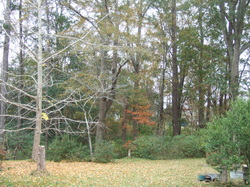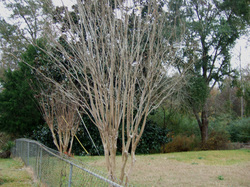
I have always liked the look of Alabama Novembers. To me cloudy gray days mean Thanksgiving is coming. It is a moody look, but one I happen to love. Melville's Ishmael tells us that ". . . whenever it is a damp, drizzly November in my soul . . . I account it high time to get to sea as soon as I can. This is my substitute for pistol and ball." For me the mood is more bittersweet and not nearly so dramatic.

The fall colors in Alabama tend not to be of quite the brilliance that Ishmael would have experienced in his New England. The yellows not as vibrant, the reds not as vivid. More rust colors. Perhaps more greens interspersed to soften the effect. The change to a more muted look is not as dramatic. The mood changes more gradually.

Here's the view down County Road 17, heading south. The gray of the road seems to echo the general grayness, but for me a soft and gentle grayness, muted. If it were a song it would surely be in a minor key.

The most severe starkness of November tends to be in the spikey branches of the crepe myrtles. They lose their leaves early, not that their small leaves are ever anything to brag about, certainly nothing to equal the wonderful colors of their blooms in the summertime. Me, I like this starkness and find it a pleasant contrast.


We in the South like our dogwoods. They have particular beauty in every season. In the early fall they present some of the earliest most nearly vibrant colors. By now they have gone way past their fall prime, but they still have their attractive qualities.

Most of my dogwoods are gone now. This one in the southeast corner is the last one left in my yard. I do have one more in the woods, down from the south fence.

Only a very few yellow leaves remain on the gingko tree that my mother planted probably in the 1950s. Yes, I know it is not native to Alabama (or to the United States, for that matter), but it does have beautiful leaves; and when all have turned yellow they show up wonderfully to all Sawyerville against the dark greens of the pines and hardwoods down in my woods.


But why that one little spray of yellow remains on the tree I cannot explain.

One of the few things in bloom this time of year is the sasanqua. I have pink ones and white ones against the east side of my father's old store, which is on the west side of my front yard. This white one is in that front west side of the yard.

But in a very few weeks this camellia, which is on the east side of the house and which I can see from my office chair by craning just a bit to the left, will be covered with deep red blooms. Already you can see the buds. And down the hill the greenery for next fall's spider lilies has started to poke up out of the ground.

The nandinas have produced their red berries. Nandina is a hardy species. I suspect that when cockroaches take over the world, this may be the only plant still to survive. It is harder to kill than kudzu and wisteria. These berries are on the row that line the west side of my pumphouse.

Yes, Alabama Black Belt Novembers are not nearly as exciting as the spectacular fall seasons in other parts of the country . . .

. . . but in their quiet and unassuming way they bring me a surprising degree of pleasure.
 RSS Feed
RSS Feed